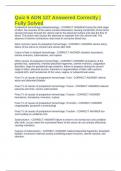Quiz 6 ADN 127 Answered Correctly |
Fully Solved
Postpartum hemorrhage pathophysiology - CORRECT ANSWER During the third stage
of labor, the muscles of the uterus contract downward, causing constriction of the blood
vessels that pass through the uterine wall to the placental surface and stop the flow of
blood. This action also causes the placenta to separate from the uterine wall. The
absence of uterine contractions may result in excessive blood loss.
Most common cause of postpartum hemorrhage - CORRECT ANSWER uterine atony,
failure of the uterus to contract and retract after birth
Cause of late or delayed hemorrhage - CORRECT ANSWER obstetric lacerations,
uterine inversion, subinvolution, and rupture
Other causes of postpartum hemorrhage - CORRECT ANSWER lacerations of the
genital tract, episiotomy, retained placental fragments, uterine inversion, coagulation
disorders, large-for-gestational-age newborn, failure to progress during the second
stage of labor, placenta accreta, induction or augmentation of labor with oxytocin,
surgical birth, and hematomas of the vulva, vagina, or subperitoneal areas.
Fives T's of causes of postpartum hemorrhage: Tone - CORRECT ANSWER Uterine
atony and distended bladder
Fives T's of causes of postpartum hemorrhage: Tissue - CORRECT ANSWER retained
placenta and clots, uterine subinvolution
Fives T's of causes of postpartum hemorrhage: Trauma - CORRECT ANSWER
lacerations, hematoma, inversion, rupture
Fives T's of causes of postpartum hemorrhage: Thrombin - CORRECT ANSWER
coagulopathy (acquired or preexisting)
Fives T's of causes of postpartum hemorrhage: Traction - CORRECT ANSWER too
much pulling on umbilical cord
Subinvolution - CORRECT ANSWER failure to return to its normal size and condition
after birth. occurs when the myometrial fibers of the uterus do not contract effectively,
causing relaxation.
Causes of subinvolution - CORRECT ANSWER retained placental fragments, distended
bladder, excessive maternal activity prohibiting proper recovery, uterine myoma, and
infection.
, Complications of subinvolution - CORRECT ANSWER hemorrhage, pelvic peritonitis,
salpingitis, and abscess formation
What does subinvolution look like? - CORRECT ANSWER The clinical picture includes
a postpartum fundal height that is higher than expected with a boggy uterus; the lochia
fails to change colors from red to serosa to alba within a few weeks.
Uterine tone - CORRECT ANSWER The uterus can clamp down on itself to constrict
the uterine blood vessels to clot abnormal bleeding. most commonly results from
overdistention of the uterus.
Causes of Overdistention of the Uterus - CORRECT ANSWER 1. Multifetal gestation
2. Fetal macrosomia
3. Hydraminos
4. Fetal abnormalities
5. Placental fragments - large uterus with painless dark-red blood mixed with clots;
retained products of conception
6. Prolonged, rapid, or forceful labor, especially if stimulated by oxytocin
7. Bacterial toxins (chorioamnionitis, endomyometritis, septicemia)
8. Use of anesthesia, especially halothane
9. Use of magnesium sulfate when treating preeclampsia
Uterine Trauma - CORRECT ANSWER Lacerations, hematomas, uterine inversion,
uterine rupture. Can occur after prolonged labor, manipulation of fetus.
Lacerations of uterus - CORRECT ANSWER 1. Cervical - mother started pushing
before fully dilated or a forceps delivery
2. Side-wall - occur with operative vaginal births or if hand presents with fetal head. Can
also be spontaneous.
These can arise from manipulation of fetus to prevent shoulder dystocia. They can
cause significant blood loss.
Uterine inversion - CORRECT ANSWER when the top of the uterus collapses into the
inner cavity due to excessive fundal pressure or pulling on the umbilical cord when the
placenta is still firmly attached to the fundus after the infant has been born.
Uterine inversion treatment - CORRECT ANSWER giving uterine relaxants and
immediate manual replacement by the health care provider. Do not replace in a non
sterile setting.
Uterine rupture - CORRECT ANSWER When your uterus tears or breaks open. more
common in women with previous cesarean incisions or those who have undergone any
procedure resulting in disruption of the uterine wall, including myomectomy, perforation
of the uterus during a dilation and curettage, biopsy, or intrauterine system insertion.




